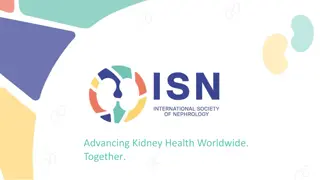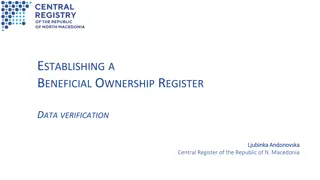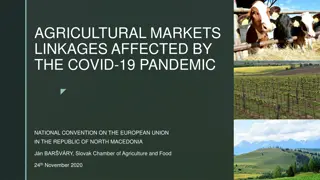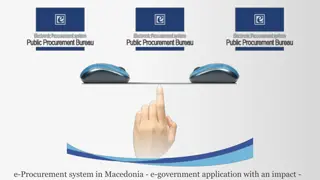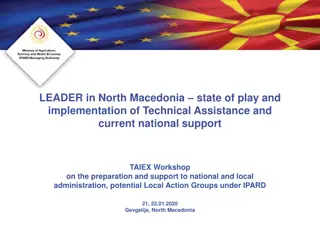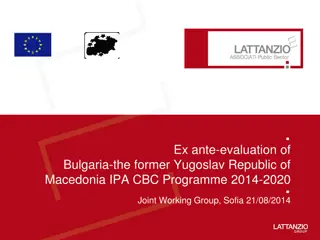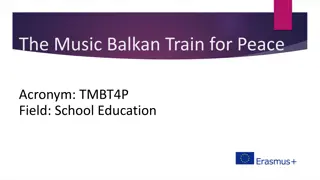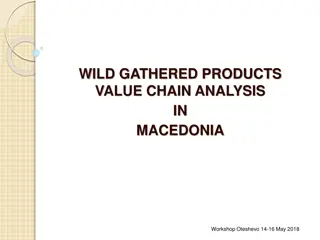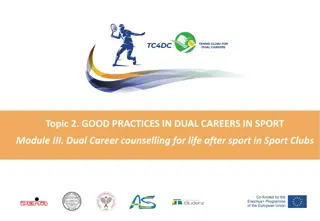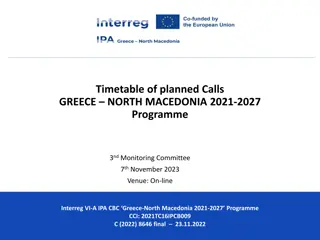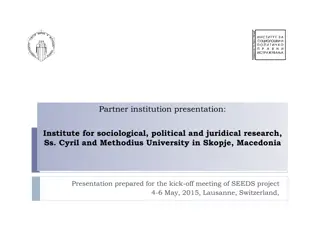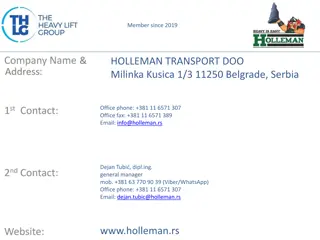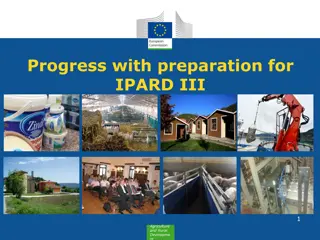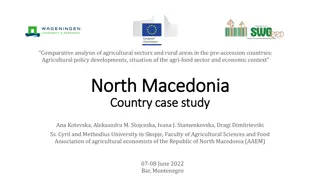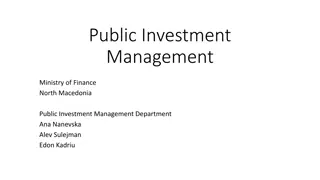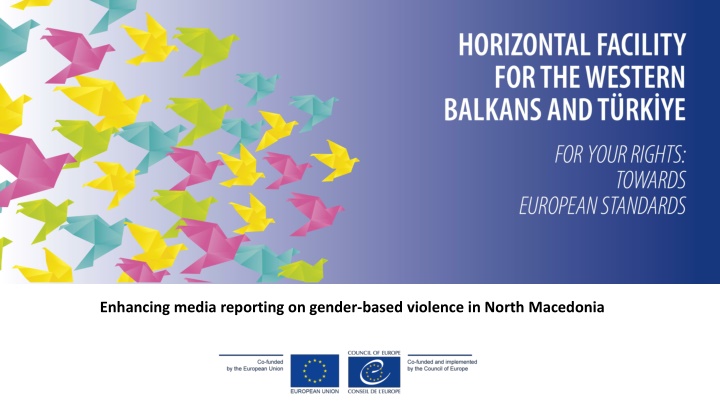
Enhancing Media Reporting on Gender-Based Violence in North Macedonia
Learn about the importance of enhancing media reporting on gender-based violence in North Macedonia to combat the widespread issues of assault, harassment, stalking, and violence against women. Discover the regulatory approaches, common objectives, and self-regulatory principles aimed at promoting ethical reporting, challenging stereotypes, and protecting women's rights.
Download Presentation

Please find below an Image/Link to download the presentation.
The content on the website is provided AS IS for your information and personal use only. It may not be sold, licensed, or shared on other websites without obtaining consent from the author. If you encounter any issues during the download, it is possible that the publisher has removed the file from their server.
You are allowed to download the files provided on this website for personal or commercial use, subject to the condition that they are used lawfully. All files are the property of their respective owners.
The content on the website is provided AS IS for your information and personal use only. It may not be sold, licensed, or shared on other websites without obtaining consent from the author.
E N D
Presentation Transcript
Enhancing media reporting on gender-based violence in North Macedonia
Why we need to seek ways to enhance reporting on gender-based violence? Gender-based violence is widespread : 1 in 5 women have been assualted by an intimate partner 1 in 2 women has experienced sexual harassment 1 in 5 women has been stalked 2 in 5 women have been killed by current or ex-partner
Gender based violence in RNM 14% of women have experienced violence since the age of 15 44% of women have experienced psychological violence 30% of women have been sexually harassed since the age of 15 Most likely these are severely under-reported numbers
Regulatory approaches aim at a. supporting self-regulation and ethics in the professions b. Providing stronger frameworks that conform to European and international law agreements Practices and attitudes of stakeholders involved in meaning making especially the media are central to support cultural and social change
common regulatory objectives Prevent discrimination and violence against women and girls, Protect women from violence, Challenge stereotypes underscoring cultural normalization of violence against women, Promote understanding and raising awareness about violence against women constituting violation of women s human rights, Prevent re-victimisation, Protect from discrimination, Pursue a policy agenda countering violence against women through integrated policies according to the Istanbul Convention.
Widely accepted self-regulatory principles Responsibility for respectful reporting, especially in relation to specific matters such as violence, hate speech, vulnerable groups. Sensitisation to matters and targets of discrimination, such as gender and intersectional markers in reporting. Responsibility to counter violation of and to protect human rights. Responsibility to not incite hatred on the basis of sex among other things. Responsibility to not promote discrimination. Responsibility to do no harm while reporting.
Regulatory provisions Articles 6 and 9 and Recital 4 of the Directive (EU) 2018/1808 of the European Parliament and of the Council of 14 November 2018 amending Directive 2010/13/EU on the coordination of certain provisions laid down by law, regulation or administrative action in Member States concerning the provision of audiovisual media services (Audiovisual Media Services Directive) in view of changing market realities. Article 21 of the EU Charter of Fundamental Rights
European Convention on Human Rights 1950, Article 10, Article 14 and Article 17 Protocol No. 12 the Convention for the Protection of Human Rights and Fundamental Freedoms Convention on Preventing and Combating Violence against Women and Domestic Violence (Istanbul Convention) , Article 12, Article 17, Article 18, Article 42, Article 34, Article 40 Recommendation CM/Rec(2013)1 of the Committee of Ministers on Gender Equality and Media The Law on Audio and Audiovisual Media Services: Article 61, Article 48
Widely accepted regulatory objectives:media reporting gender violence against women Promote respect for human rights in relation to women and gender violence against women. Combat violence against women through combating stereotypes about women; men; gender roles and gender value in society. Do not partake in victimization and revictimization and refrain from reproducing sexist stereotypes and those related to intersectional traits, such as gender and ethnicity. Exercise critical reporting in relation to cases of violence and violence as a social phenomenon, including institutional responsibility. Provide content which adheres to professional ethics and codes of conduct and the principles of the right to free speech in countering violence against women. Freedom of expression is not equal to the violation of other human rights such as non- discrimination, dignity, freedom from violence. Protect vulnerable individuals, victims and survivors of violence, such as minors, in reporting.
Widely identified persistent bad practices of the media in covering violence against women in international and longitudinal studies Lack of reporting on social context within which male perpetrators are violent against women and children. Perpetuation of myths, misrepresentations and stereotypes. Assigning blame and responsibility to victim-survivors. Limited expert voices, predominantly law enforcement. Limited display of sensitivity and knowledge about impact, harm and consequences of violence for victims and for communities.
Guidelines on monitoring reporting a. parameters setting for preliminary overview: Duration of the report Previous story theme and duration Following story theme and duration Story and subject matter Who appears to have a voice, who is quoted Who remains silent Who seems to be protected: perpetrator of violence? Victim/survivor? What sort of images accompany the story.
b.Contextualenvironment 1. I. What areas of gender based violence against women are described in the report? Abuse against women on the basis of gender and gender specific actions e.g. breastfeeding Cyberbullying, online harassment, hate speech Child marriage/early marriage/forced marriage Controlling behaviour including economic violence Female genital mutilation/cutting Femicide/infanticide Psychological, emotional abuse Blackmail/abuse of children Sexual harassment, sexual assault, rape So-called honour crimes Trafficking of persons, smuggling Violence against women in conflict, armed conflict Violence against women in elections, political participation, public participation Violence by intimate partner/ex-partner, domestic violence/murder Reproductive violence against women (by the state, authorities, medical institutions etc.) Other
II. Violence against women in the public eye e.g. journalists, politicians, public persons, activists, authors Violence in politics i.e. elections, referendum, demonstrations Violence in the contexts of sports events Violence in the context of cultural events Violence in the context of crisis Other What is the current socio-political context of the violence?
III. What are the grounds of the complaint/of the case? IV. across media with the same or similar content? Can similar breaches be identified over a period of time or V. possible? Are media owned by the same company or adhere to same editorial control? Is the author/are the authors the same? Are the authors identifiable? Is this a copy-paste story? Is there a pattern of treatment of the subject of violence
c. Assess contextual information and tone of the story Does the report describing violence leave any doubt that this is a violent incident? Does the report generate confusion as to the issue of violence against women? Is the tone used for describing the event in any way inciting to judgment, in particular towards the victim/survivor? Does the report present the event without contextual information about violence against women? Does the report tend to minimize the extent and seriousness of violence against women in any way e.g. visuals, heading, tone of presentation and other audio, comments? Does the report in any way reinforce, legitimise, normalize or excuse sexist views about women and justifies violence? Does the report violate any of the professional standards?
Specific questions to the content of the story/item Regarding the victim/survivor Is the person/are the persons portrayed in any way as weak and hence responsible for not protecting herself? Is the person/are the persons portrayed as too stupid or too irresponsible for not protecting herself? Is the person/are the persons portrayed as provocative, inviting, asking for it especially in a sexual manner? Is the person/are the persons portrayed as becoming a victim/survivor in relation to their appearance? Is the person/are the persons portrayed as in any way deserving violence due to their sexual or cultural moral behaviour, their past, ethnicity or their associations? Is the person portrayed in any accusatory or degrading manner? Is the person portrayed as responsible in any other way for being attacked?
Portrayal of abuser/attacker Is the person/are the persons portrayed as unstable? Is the person/are the persons portrayed as monsters ? Is the person/are the persons portrayed as being forced to assault/abuse? Is the person/are the persons portrayed as committing a crime of passion ? Is the person/are the persons portrayed as having no choice (but to commit a violent crime)? Is the person/are the persons portrayed as violent due to their race/class/education and hence as outside the norm?
Portrayal of the event Is this portrayed as an isolated incident? Is this portrayed as an extraordinary incident standing out from an otherwise violent-free society? Is this portrayed as a crime of passion /honour and generally of higher cultural morals ? Is this portrayed as a sacrifice for the greater good ? Is this portrayed as a lesson and warning to other women? Is this portrayed as a private matter? Is the event attributed predominantly on extraordinary conditions such as technology promoting violent speech? There have been cases when it was portrayed as expression/form of love does passion cover for this, or is passion here understood as spur of the moment ?
Specific communicative devices of the reporting Language Is imprecise or inaccurate language used to describe the event? Are words used with cultural significance, in particular with derogatory meaning? Do headings or running titles and other textual aids misguide and misrepresent the story? Is language at any point a tool to serve the questions asked in relation to the abuser, victim/survivor and event? Is language inviting to judgement or justification of violence against women? Is language used to glamourize or sensationalise violence? Is language being used to lecture ? Is language producing secondary victimization? Is the tone of the item forceful, disrespectful or intrusive in particular in relation to addressing survivors? Is the tone of the item forceful or manipulative in particular addressing minors? Is the language stereotypical? Is language passive and suggestive of blame Could you please clarify this?
Interviews with victims/survivors Is there any breach of protocol and expected ethics when interviewing children or other vulnerable individuals? Is the name or face or other characteristics of the victim/survivor public or information in the report can lead to their identification without their consent or judicial permission? Is the appropriate interpreter used where applicable? Is the perpetrator interviewed and his views accepted and directly or indirectly used as allowing problematic parts of the interview and act uncommented upon by the journalist
Is there use of unauthorized visual footage of the victim/survivor? Is visual material used of the victim, presenting the victim/survivor in an unfavourable manner and is therefore suggestive of blame? Is imagery conducive to accusatory or degrading treatment towards the victim/survivor? Is the selection of visuals and their editing precise and true to the accurate and respectful representation of the event? Are visuals too graphic and disturbing without conveying information? Are they used to sensationalise the story? Do images infantilise or disempower women?
Overall coverage Does the reporting endanger further the safety of the victim/survivor or her dependents? Is the male perpetrator of violence invisible (whether in text or images) in the reporting? This is done by focusing on an event (violence) happening on a victim/survivor. Is the reporting ambiguous and ambivalent concerning the dynamics, impact and harm of violence against women? Does the reporting minimise the harms of violence? Common tools are the trivialisation of violence and women s claims and dehumanisation of women. Does the reporting produce any arguments or suggestions that justify violence against the specific victim/survivor and/or violence against women in general?
Good practice in reporting Widely accepted principles of good practice in media reporting on GBV Refrains from justifying, excusing, sensationalising, trivialising or glamorising any form of GBV through language, visual or other communication tools. Refrains from presenting violence against women as an isolated incident and/or perpetrators as monsters , unstable or an extreme situation. Provides context and information useful for survivors. Treats violence against women as a human right, a matter of human security and a matter of democratic concern. Does not assign blame on the victim/survivor; does not re-victimise survivors.
Is sensitised to issues of intersectionality and impact of violence on the victims/survivors dependents/family. Provides platform to the voices of victims/survivors without infringing dignity and respect, by seeking the input of NGOs, civil society organisations. Shows life after violence: provides role models for hope, empowerment and agency. Addresses boys and men as partners in combating violence in all stages of life


